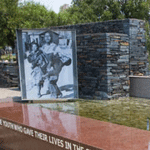This Day in History: June 16, 2002
Additional Date: June 16, 2002
The Hector Pieterson Museum, the first museum in Soweto, was opened on 16 June 2002. The Museum is situated on Kumalo Street in Orlando West, and is named after Hector Pieterson, one of the first casualties of the 1976 uprising against the use of the Afrikaans in schools.
Another boy, Hastings Ndlovu, is believed to have been the first child to be shot by police on that fateful day. Earlier in the 1990s, a memorial to Hector Pieterson was erected in front of the museum site, two blocks from where Hector was shot.
The museum houses photographic and audio-visual displays that follow the chronological build-up to 16 June 1976. It begins with the rising tension among Soweto's school children, with one school after another going on strike. Approximately 566 schoolchildren were killed during these protests, and 16 June has subsequently been observed as a public holiday called 'Youth Day' since 1994.
Soweto is an area of South Africa that is rich in the history and heritage of the struggle for freedom against Apartheid. It has become a popular destination for tourists, and memorial sites like the Hector Pieterson museum add to the appeal and conservation of Soweto's history.
As the Soweto tourism website states:
"Soweto is a symbol of the New South Africa, caught between old squatter misery and new prosperity, squalor and an upbeat lifestyle, it's a vibrant city which still openly bears the scars of the Apartheid past and yet shows what's possible in the New South Africa".
